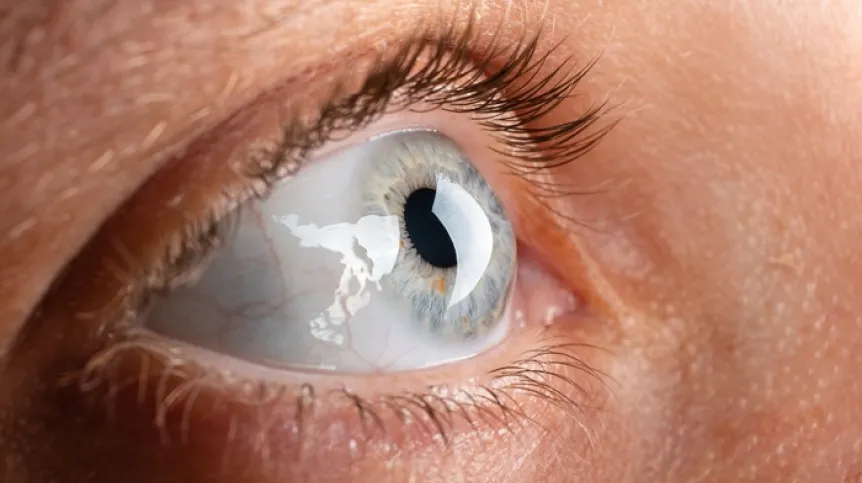
Polish scientists have identified microRNA molecules that may be involved in the pathogenesis of a disease called keratoconus by interfering with key molecular processes, including the organization of the extracellular matrix and signalling.
Their research was conducted on the world's largest collection of corneas from patients with keratoconus and from a control group.
Keratoconus (KTCN) is a progressive degenerative disease that causes thinning and bulging of the cornea. The resulting distortions lead to a significant deterioration of visual acuity. The disease usually affects both eyes and begins in adolescence or early adulthood. It affects an average of 1 in 2,000 people.
'Early or even moderately advanced keratoconus is often diagnosed by chance, because the cornea at this stage may look normal during an ophthalmological examination using a slit lamp. Early symptoms are not specific, they include slight blurring in the field of vision, double or hazy vision, which cannot be corrected with glasses or contact lenses. Only a comprehensive examination including tomography of the cornea and the anterior segment of the eye allows to diagnose keratoconus', Professor Marzena Gajęcka from the Institute of Human Genetics of the Polish Academy of Sciences tells PAP - Science in Poland.
When it comes to methods of combating keratoconus, neither surgical nor non-surgical therapies treat its causes. They also cannot reverse the damage that has already occurred. They only slow down or stop further progression of the disease and consist in correcting the patient's visual acuity.
'The available treatment methods include the use of contact lenses, implantation of intracorneal rings, collagen fibre cross-linking procedure and finally keratoplasty, i.e. corneal transplantation', says Dr. Katarzyna Jaśkiewicz-Rajewicz from Professor Gajęcka's research group. She adds that KTCN is the second most common cause of corneal transplants in the world, but - like in the case of other organs - the waiting list for a transplant is very long. 'Therefore, we have high hopes for cell and gene therapies, which at the moment remain in the sphere of scientific research and few clinical trials', she says.
The exact cause of keratoconus is not yet known. We do know that it is a multifactorial disease: it can have both a genetic and environmental causes (including intensive eye rubbing or asthma).
KERATOCONUS AND GENES
The team from the Institute of Human Genetics PAS focused on the genetic causes. Professor Gajęcka says that earlier studies have identified many genes that may be responsible for this condition. Among them are the VSX1, DOCK9, STK24, IPO5 and TGFBI genes identified by the same team, and even longer genome fragments (so-called chromosomal loci). 'But unfortunately, in the case of these results, there is often a lack of repeatability within different families or ethnic groups. It is therefore difficult to find aspects that are consistent for the world population', Professor Gajęcka says.
Precisely because of the difficulties in finding the genetic causes of KTCN the scientists decided to combine different research methods, analysing different elements of genetic information, in order to fully decipher the molecular background of KTCN. 'We try to combine various biological aspects and data from high-throughput analyses. We have already performed research at the genome, transcriptome and proteome levels, i.e. changes in DNA, RNA and proteins. Last year, we were the first team in the world to publish a paper based on whole genome sequencing (WGS) of patients with KTCN', says Professor Gajęcka.
'In addition, we also obtain epigenetic data that will help us understand what other elements, apart from the DNA sequence, influence gene expression changes in the course of KTCN. In this aspect, we are investigating, for example, DNA methylation, microRNA and the opening of the chromatin structure', adds Dr. Jaśkiewicz-Rajewicz.
The team has also developed a new research model of the human cornea, covering all its layers, and introduced the term 'topographic region' to the scientific literature to better determine the location of pathological changes within each layer.
As a result of their research, the scientists proposed a scheme of the mechanism of corneal epithelium reconstruction in the course of KTCN, in which they indicated the induction of the apoptosis (i.e. cell death) process and features of the epithelial-mesenchymal transition resulting from the accumulation of growth factors, cytokines and neutrophil degranulation products, which change the interactions between cells and promote their migration. 'In such a situation, inflammation occurs, which is important and necessary in the short term, because it has a protective effect, but in the long term it is harmful. This is what happens in the case of patients with KTCN, in whom additional factors appear, such as compulsively/intensely rubbing the eyes or immune response disorders, which make the inflammation and wound healing process permanent', says Dr. Jaśkiewicz-Rajewicz.
KERATOCONUS AND EYE RUBBING
As for other factors contributing to the development of keratoconus, knowledge about them is still incomplete. For example, it is still not clear whether rubbing the eyes is crucial for the development of the disease. 'There is no clear answer to this question. We know that rubbing has a negative effect and intensifies the ongoing process. At the same time, we are inclined to support the opinion that rubbing alone, however intensive it may be, is not sufficient to trigger the cascade of events leading to the development of keratoconus', Gajęcka adds.
In their latest analysis of environmental and behavioural factors for KTCN (10.1371/journal.pone.0284454), her team showed that, in addition to rubbing the eyes, the most important risk factors are: male gender, time spent in front of a computer after work/school, and the presence of dust/pollen in the work environment.
Additionally, the researchers identified genes whose expression in the corneal epithelium is correlated with the method and intensity of eye rubbing. These were genes related to the processes of apoptosis, cell adhesion or cellular stress, but none of them were associated with allergies, which in previous studies by other teams were presented as one of the main risk factors of KTCN.
The results of scientists from the Institute of Human Genetics PAS on environmental factors, and in particular the characteristics of the ways in which patients with KTCN rub their eyes, gained the approval of the American National Keratoconus Foundation and were reprinted in the foundation's newsletter (https://nkcf.org/may-2023-update-newsletter).
KERATOCONUS AND THE INFLAMMATION PROCESS
New research has also shown that the inflammatory process is one of the main elements of the molecular image of KTCN. Historically this disease was considered to be a non-inflammatory disorder and this view still functions in some environments today, but it is questioned by many clinicians and researchers. 'Recently, the association of KTCN with significant changes in the range of inflammatory mediators (…) has been repeatedly noted, thus indicating a persistent inflammatory state', the researchers say.
'In our studies that included whole-genome sequencing (10.1167/iovs.64.2.22), we indicated numerous variants of coding and non-coding gene sequences that could be important in the processes of innate and adaptive immune response. This result indicates genetic aspects in the inflammatory background of KTCN. Immune system disorders, including antigen presentation processes and neutrophil degranulation, affect corneal haemostasis, which may result in thinning and weakening of the tissue', says Dr. Jaśkiewicz-Rajewicz.
She adds that although single sequence variants may affect the KTCN phenotype in some families, the obtained genomic data suggest that the disease may largely be the result of the interaction of many variants that disrupt the physiological processes of the cornea.
A CHANCE FOR NEW METHODS OF DIAGNOSIS
Professor Gajęcka believes that translating the research conducted at the Institute of Human Genetics PAS into practice would be extremely valuable, because the discovery of a highly sensitive biomarker specific to this disease would improve diagnostics, which is currently difficult due to limited patient access to specialist ophthalmological equipment. It is also important to find markers predicting whether the progression of the disease will be rapid and whether it is worth immediately implementing surgical treatment.
The team already has a candidate that can perform this function - it is the mir-184 molecule. It belongs to the family of microRNAs (miRNAs), a highly conserved class of small, non-coding RNAs that play an important role in the regulation of gene expression.
'In our latest publication (10.3389/fgene.2024.1301676), we identified several miRNAs characterized by an altered level of expression in patients with KTCN. Specifically, these were pre-miRNAs, i.e. molecules from which mature miRNAs are later produced. Among them was the mir-184 molecule, previously reported to be involved in KTCN and other corneal diseases. Previous studies found causative mutations in the mir-184 gene in British, Irish and Australian families with keratoconus. These data, as well as the fact that mir-184 is expressed in the cornea, suggest its role as an important regulator of the development and homeostasis of this part of the eye', Professor Gajęcka says.
… AND NEW TREATMENT METHODS
In addition to searching for biomarkers, the Polish research aims to find a protein, molecule or signalling pathway that could become the target of medical intervention in the form of gene or cell therapy. However, as the scientists emphasise, the road to this is very long, because for now there is no adequate research model, e.g. a 3D microphysiological model of the cornea (i.e. a 'cornea on a chip' model).
'The models created and published so far are not fully functional; they usually contain only epithelial and endothelial cells, which means that the proper substance, which is most responsible for the biomechanics of the cornea, is missing. Therefore, an adequate model should be developed first, and then used to examine the effect of selected substances on the cornea', says Professor Gajęcka.
She adds that she and her colleagues are optimistic. 'We believe that thanks to the cooperation between the Institute of Human Genetics PAS and clinical units, we will contribute to the still nascent research on cell therapies. And in parallel to our research, we are trying to raise public awareness of KTCN’.
Basic research on keratoconus is conducted thanks to financial resources obtained from the Polish National Science Centre.
PAP - Science in Poland, Katarzyna Czechowicz
kap/ zan/
tr. RL













